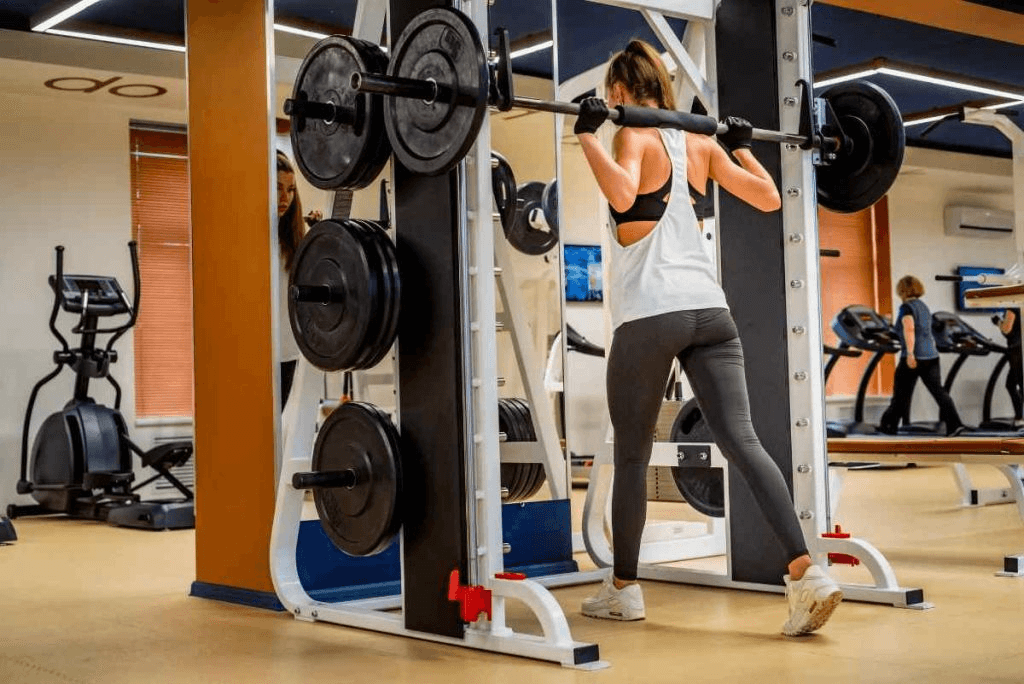Wondering how to improve your upper body strength and stability? The single arm cable row is your answer. This exercise targets your back muscles, enhances core stability, and corrects imbalances. In this guide, learn the correct form, benefits, and variations for optimal results.
Key Takeaways
-
The single arm cable row enhances muscle balance, core stability, and upper body strength by targeting underdeveloped areas and promoting unilateral strength.
-
Proper execution, including maintaining tension, avoiding twisting, and emphasizing full range of motion, is crucial for maximizing the exercise’s effectiveness and preventing injury.
-
Incorporating variations and progression strategies, such as adjusting sets, reps, and weight, can significantly improve results and help correct muscle imbalances.
Benefits of the Single Arm Cable Row

Incorporating the single arm cable row into your workout routine can lead to significant improvements in muscle balance, core stability, and overall upper body strength. This exercise targets underdeveloped areas in the upper body and strengthens core and back stability, making it a vital component of any comprehensive fitness program.
Performing one hand arm at a time enhances activation and unilateral strength, allowing both sides of your body to develop evenly.
Balanced Muscle Development
Unilateral exercises like the single arm cable row promote balanced muscle development. Isolating each side ensures balanced growth in major back muscles such as the lats, traps, and rhomboids. This method addresses specific weaknesses, resulting in significant muscular gains and enhanced overall back aesthetics and function.
A full range of motion maximizes muscle engagement and strength gains during the single arm cable row.
Enhanced Core Stability
The single arm cable row significantly enhances core stability by improving strength through the trunk and resisting rotation and lateral sway. The standing version of this exercise, in particular, promotes greater activation of stabilizing muscles in the core, ensuring you maintain balance and control throughout the movement.
This strengthens your core while improving overall stability and functional fitness.
Improved Posture and Spinal Health
One of the standout benefits of the single arm cable row is its positive impact on posture and spinal health. This exercise helps combat rounded shoulders by promoting better spinal alignment and muscle engagement. Incorporating a pause at the peak of the contraction can further enhance muscle engagement and improve your posture.
Proper execution prevents muscle imbalances and back strain, ensuring you reap the full benefits of the exercise.
How to Perform a Single Arm Cable Row

Performing the single arm cable row correctly is crucial for maximizing its benefits and preventing injury. The exercise involves three main phases: the starting position, the pulling technique, and the lowering phase. Each phase requires careful attention to form and control to ensure effective muscle engagement and overall workout effectiveness.
Starting Position
Begin by setting up your starting position properly. Stand with your feet shoulder-width apart, knees slightly bent, and your back straight. Keep your shoulders square and in line with your hips. Engage your core to build stability and prevent any unwanted twisting throughout the movement.
This foundational step ensures proper alignment and posture, setting the stage for effective muscle engagement.
Pulling Technique
For the pulling phase, grip the hand handle with a neutral grip and position it in front of your belly button while fully extending your arms. Keep your shoulder relaxed and your elbow close to your body as you pull the handle towards you, focusing on engaging your back muscles.
Drawing your shoulder blades together at the peak maximizes muscle engagement and effectively targets the intended muscle groups.
Lowering Phase
The lowering phase is just as important as the pulling phase. Slowly straighten your arm to lower the weight back to the starting position, maintaining tension throughout the movement. Keeping your torso straight and controlled aids in effectively targeting the back muscles during the row.
This controlled motion prevents injury while maximizing muscle engagement and the effectiveness of the exercise.
Tips for Maximizing Your Single Arm Cable Row

To get the most out of your single arm cable row, focus on key elements such as maintaining control, avoiding twisting, and emphasizing the stretch and squeeze. Each of these aspects plays a crucial role in ensuring effective muscle engagement and preventing injury.
These tips enhance the overall effectiveness of your workout and lead to better results.
Focus on Tension and Control
Maintaining tension and control throughout the exercise maximizes its effectiveness. Control every rep from start to finish, focusing on a slow, deliberate return to the starting position to maximize muscle tension. Altering the tempo can serve as a progression method, emphasizing control and time under tension.
Maintain a neutral spine to avoid unnecessary back strain and ensure proper form.
Avoid Twisting
Avoid twisting your torso to maintain stability and effectiveness. Pull the handle towards your torso with your elbow tucked to your side. Squeeze your shoulder blade at the top and hold for 1–2 seconds to enhance muscle engagement.
Start by listing a weight that allows for controlled movements, as lift excessive weight can compromise your form and increase the risk of injury.
Emphasize Stretch and Squeeze
Emphasizing the stretch at the start of the movement and the squeeze at the peak is vital for maximizing muscle engagement. Using the full range of motion ensures you achieve optimal muscle activation and effectiveness of the row.
Focusing on the stretch and squeeze ensures optimal recruitment of target muscles, leading to better results and enhanced muscle development.
Variations of the Single Arm Cable Row

Incorporating variations of the single arm cable row can help in progressing the exercise and targeting different muscle groups. These variations, including the seated, standing, and kneeling single arm cable rows, can enhance muscle activation and prevent workout monotony.
Modifying the angle of pull or changing the attachment continues to challenge your muscles and achieve better results.
Seated Single Arm Cable Row
The seated single arm cable row is an effective variation that enhances strength and muscle definition in the upper back. This exercise emphasizes inner back thickness, and using a close grip can specifically target the lower lats and biceps. Additionally, a wide grip can be beneficial for targeting the upper traps and rear deltoids.
The seated variation aids in maintaining stability and focused muscle engagement, maximizing the benefits of the exercise.
Standing Single Arm Cable Row
The standing single arm cable row boosts core stability and balance, providing a greater challenge during the exercise. This variation enhances core muscle engagement, making it an excellent option for improving overall strength and balance.
This variation also allows for a greater range of motion, improving both strength and flexibility in the back.
Kneeling Single Arm Cable Row
The kneeling single arm cable row offers additional stability and focuses on improving posture during the exercise. This variation allows you to minimize momentum, ensuring a more controlled movement and better muscle engagement.
Incorporating the kneeling variation enhances your workout routine, leading to better muscle development and functional fitness.
Programming Your Single Arm Cable Rows

Programming your single arm cable rows effectively into your workout routine is essential for achieving your fitness goals. This exercise not only targets muscle growth but also aids in correcting muscle imbalances.
By adjusting the frequency and intensity based on your individual fitness levels, you can integrate the single arm cable row into various workout routines and see significant improvements.
Sets and Reps
For hypertrophy training, it is recommended to perform 3–4 sets of 10–12 reps per side. For strength training, you should aim for 4 to 5 sets. Each set should consist of 6 to 8 repetitions per side. If endurance is your goal, perform 3 sets of 15+ reps.
Adjusting the number of sets and reps based on your training goals ensures you maximize the benefits of the single arm cable row and achieve the desired results.
Progression Strategies
Enhance the difficulty of single arm cable rows by gradually increasing the weight or resistance. Incorporating advanced techniques like drop sets or supersets also increases the intensity and stimulates muscle growth.
By progressively challenging your muscles, you ensure continuous improvement and avoid hitting a plateau in your fitness journey.
Common Mistakes and How to Avoid Them
Avoid common mistakes that can compromise the effectiveness of the single arm cable row and increase the risk of injury. Proper form, appropriate weight selection, and ensuring a full range of motion are key factors in executing the exercise correctly.
Let’s explore these common mistakes and how to avoid them to learn get the most out of your workout.
Using Too Much Weight
Selecting excessively heavy weights can lead to improper form and increase the risk of injury. Beginners should master the technique with lighter weights before progressing. Overexertion from lifting too much weight can lead to compensatory movements, adversely affecting other muscle groups and diminishing the benefits of the exercise.
Poor Posture
Proper posture is crucial for effective performance and injury prevention. Begin with your feet shoulder-width apart, knees slightly bent, and back straight.
Ensure your shoulder blades are retracted and your chest is elevated to maintain proper alignment and engage your core to stabilize your body throughout the movement.
Incomplete Range of Motion
A full range of motion is crucial for maximizing muscle engagement and development. Focusing on tension and control throughout the movement helps ensure this power connection.
Emphasizing the stretch and squeeze during the exercise ensures optimal muscle contraction and promotes full range of motion, leading to better results.
Summary
The single arm cable row is a powerful exercise that offers numerous benefits, including balanced muscle development, enhanced core stability, and improved posture and spinal health. By mastering the proper technique and incorporating various tips and variations, you can maximize the effectiveness of this exercise. Programming it correctly into your workout routine and avoiding common mistakes will ensure you achieve your fitness goals. Remember, the key to success is consistency and attention to detail. So, take what you’ve learned, apply it to your workouts, and watch your strength and balance improve.
Frequently Asked Questions
What are the main benefits of the single arm cable row?
The single arm cable row promotes balanced muscle development while enhancing core stability, posture, and spinal health. These benefits contribute to overall strength and functional fitness.
How do I perform a single arm cable row correctly?
To perform a single arm cable row correctly, stand with your feet shoulder-width apart and engage your core. Maintain a neutral grip, keeping your elbow close to your body while pulling. Control the lowering phase for maximum effectiveness.
What are some variations of the single arm cable row?
Some effective variations of the single arm cable row are the seated, standing, and kneeling single arm cable row, each offering unique benefits for your workout. Incorporating these variations can enhance muscle engagement and address different fitness goals.
How should I program single arm cable rows into my workout?
Incorporate single arm cable rows into your workout by performing 3–4 sets of 10–12 reps per side for hypertrophy, or 4–5 sets of 6–8 reps for strength. For endurance training, aim for 3 sets of 15 or more reps.
What common mistakes should I avoid when performing single arm cable rows?
To maximize effectiveness and prevent injury when performing single arm cable rows, avoid using excessive weight, maintain proper posture, and ensure a full range of motion.











































Leave a comment
This site is protected by hCaptcha and the hCaptcha Privacy Policy and Terms of Service apply.